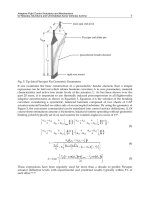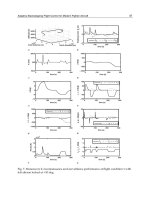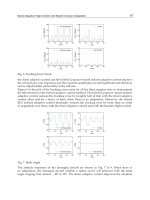Ebook Computing in geographic information systems: Part 2
Bạn đang xem bản rút gọn của tài liệu. Xem và tải ngay bản đầy đủ của tài liệu tại đây (8.58 MB, 147 trang )
7
Computational Geometry and Its
Application to GIS
Computational geometry is defined broadly as the design and analysis of algorithms for solving problems involving geometric objects. Use of the term
‘computational geometry’ and its meaning differs in different application contexts. Most researchers in computer science interpret the subject as design
and optimization of algorithms involving geometric problems. The term ‘algorithm design’ carries the connotation of discrete algorithms as opposed to
the algorithms used in numerical analysis. The numerical analysis problems
are used for solving computational problems in continuous domains. Computational geometry is useful in solving problems of discrete combinatorial
geometry rather than continuous geometry. This chapter describes the computational geometric algorithms in the context of their applications in GIS and
how these algorithms are used to process spatial data which are the primary
inputs of GIS.
Computational geometry emerged as a field of research three decades ago.
Since this area has been identified, a number of core geometric problems have
emerged. A number of computational geometric algorithms have been designed
to solve these problems. These algorithms are optimized for their computation time and memory. Research in computational geometry is progressing to
compute large volumes of geometric data and degenerate data. Therefore the
robust versions of these algorithms have been devised for processing the degenerate spatial data often encountered by GIS. These algorithms are important
for many applications, of great generality and applicability.
7.1
Introduction
Many of the problems that arise in application areas such as computer graphics, computer-aided design and manufacturing, robotics, GIS, computer vision,
human-computer interface, astronomy, computational fluid dynamics, molecular biology etc. can be described using discrete geometrical structures. These
problems can be solved using a set of algorithms known as computational
geometric algorithms. However it should be remembered that not all the geo-
119
120
Computing in Geographic Information Systems
metric applications can be modelled using the discrete geometric structures or
solved using computational geometric algorithms. For example, problems in
computer vision and computer graphics to some extent are not modelled on the
Euclidean plane, but using a matrix of digitized locations of pixels. Problems
in computer-aided manufacturing often involve curved surfaces rather than
polyhedral surfaces. Problems in fluid dynamics are generally of a continuous
nature defined by differential equations. Thus, computational geometry as it
is commonly defined is not quite broad enough to address all problems in all
these areas. However, the field is broad enough such that virtually all of these
application areas can use some of the algorithms in computational geometry.
A good introduction to computational geometry along with the algorithms
and data structures has been compiled by Preparata and Shamos in [49].
The algorithms in computational geometry discussed in this chapter along
with their applications to GIS in the context of processing spatial data pertaining to land, sea and air are listed below.
1. Algorithms to determine line-line intersection.
2. Algorithms to find whether a point lies inside a triangle, polygon,
circle, or sphere.
3. Algorithms for computing convex hull.
4. Computing triangulation of a simple polygon in 2D.
5. Computing Delaunay triangulation of a set of points in a plane.
6. Computing the Voronoi tessellation of a set of points in a plane.
These sets of algorithms are often called Computational Geometric Algorithmic Library (CGAL). The input to CGAL algorithms are typically a finite
collection of geometric elements such as points(locations associated with place
names in the map), lines or line segments (communication lines such as roads,
rails, power transmission lines etc.), polygons (coverage of states within the
geographic boundary of a country, water bodies), polyhedrons, circles, spheres
in the Euclidean space.
7.2
7.2.1
Definitions
Triangulation and Partitioning
Triangulation is a generic method for subdividing a complex domain into a disjoint collection of ‘simple’ objects. A triangle is the simplest region into which
one can decompose a plane and this process is known as triangulation. The
Computational Geometry and Its Application to GIS
121
higher dimensional generalization of a triangle in 3D is a tetrahedron. Therefore a 3D bounded volume can be decomposed to tetrahedrals. Triangulation
or domain decomposition or tessellation is typically a first step performed in
number of algorithms. These triangles are then subjected to computational
operations through an iterative process to compute the objective and analyze
the overall domain.
Triangulation ‘T ’ is tessellation of a polygonal region of the plane into nonoverlapping, continuous triangles Ti such that, their intersection is empty, or
it is coincident with a vertex, or an edge of both triangles.
|Ti |
T =
Ti
(7.1)
i=1
where, |ti | is the number of triangles in the domain. Hence the domain of T
is the plane curved by its triangles. In addition to the above definition, if the
triangulation of the domain is such that, the circumcircle of each triangles
does not contains any other points of the domain then it is called Delaunay
Triangulation (DT). This is known as the empty circumcircle property of DT.
7.2.2
Convex Hull
Perhaps the first problem in the field of computational geometry is the problem
of computing convex hulls, that is, the smallest convex shape that surrounds a
given set of objects. In other words, it suffices to say that the convex hull can
be imagined as a stretched elastic membrane surrounding the objects which
snap tightly around the objects. It is an interesting problem both because of
its applications as an initial step towards solving other algorithms, and the
number of interesting algorithmic approaches that have been devised to solve
this problem.
Mathematically Convex Hull (CH) can be defined through the set theoretic
operations as follows.
Let S be a set of discrete objects in 2D plane. The set S is convex if
¯ S
X S ∧ Y S ⇔ XY
(7.2)
Generally segment xy
¯ is the set of points x, y of the form αx + βy = 1 and
α ≥ 0 and β ≥ 0.
7.2.3
Voronoi Diagram and Delaunay Triangulation
Given a collection of points in space, perhaps the most important geometric
data structures for describing the relationships among these points and the
122
Computing in Geographic Information Systems
relationship of any points in space to these points are very well addressed
by structures of the Voronoi diagram and DT. A number of important problems such as the notion of ‘proximity’ and ‘line of sight’ can be solved using
these two structures. These structures possess a number of beautiful mathematical properties that distinguish them as important geometric structures.
Informally, the Voronoi diagram of a finite set of points in the plane is a subdivision of the plane into disjoint regions, one for each point. The Voronoi
region of a point consists of the points in the plane for which this point is the
closest point of the set. The dual graph of the Voronoi diagram is the Delaunay
triangulation. Given a set P of M unique random points in an n-dimensional
space, Let us define a region Di such that
Di = {x : |x − pi | ≤ |x − Pj |, ∀(i, j)}
Then the collection of the subdivisions Di is defined as the Voronoi tessellation or Dirichilet tessellation of the set of points P that satisfies the
constraint
m
D=
Dm
(7.3)
m=1
7.3
Geometric Computational Techniques
The most important aspect of solving computational geometric problems is
learning the design techniques needed in the creation of algorithms. Some of
the standard algorithm design techniques pursued in solving any problems
in computer science are divide-and-conquer, dynamic programming, greedy
technique etc. These techniques work perfectly with alpha numeric data or
data where indexing and sorting can be carried out easily. Spatial geometric
data often is associated with dimension and randomness. Therefore preprocessing techniques have been developed to bring the spatial geometric data to
a representation where ordering and indexing can be applied. Some of these
techniques which are often treated as the pre-processing techniques in computational geometry are:
1. Plane Sweep
2-dimensional problems can be converted into a dynamic 1dimensional problem by sweeping an imaginary line across the place
and solving the problem incrementally as the line sweeps across. In
general, if you can solve a dynamic version of a (d-1)-dimensional
problem efficiently, you can use that to solve a static d-dimensional
problem using this technique. A radial sweep line algorithm for construction of Triangular Irregular Network (TIN) has been developed
by Mirante et al. [38]. An Implementation of Watsons algorithm for
computing 2D Delaunay triangulation is discussed in [46],[47].
Computational Geometry and Its Application to GIS
123
2. Randomized incremental algorithms
One of the simplest techniques for the construction of geometric
structures is the technique of adding objects to the structure one
by one in some order [16]. It turns out that for any data set there
may be particularly bad orders in which to insert things (leading
to inefficient running times), as well as particularly good orders
(leading to efficient running times). It is difficult to know in advance
what the proper insertion order of items should be, but it is true
for many problems that a random insertion order is efficient with
high probability.
3. Fractional cascading
One important technique needed in the design of efficient geometric
search problems is that of cascading a sequence of complex decisions
up a search tree to generate a longer sequence of simple decisions.
This technique has applications in a large number of search problems.
7.4
Triangulation of Simple Polygons
The problem of triangulating polygons can be introduced by way of an example in the field of combinatorial geometry. Combinatorial geometry is the
field of mathematics that deals with counting problems in geometry. Combinatorial geometry and computational geometry are closely related, because
the analysis and design of efficient geometric algorithms often depends on a
knowledge of how many times or how many things can arise in an arbitrary
geometric configuration of a given size.
A polygonal curve is a finite sequence of line segments, called edges
joined end to end. The endpoints of the edges are vertices. For example,
let v0 , v1 , .., vn denote the set of n+1 vertices, and let e0 , e1 , .., en−1 denote
a sequence of n edges, where ei = vi vi+1 . A polygonal curve is closed if the
last endpoint equals the first vn = v0 . A polygonal curve is simple if it is not
self-intersecting. More precisely this means that each edge ei does not intersect any other edge, except for the endpoints it shares with its adjacent edges
(Figure 7.1).
The famous Jordan curve theorem states that every simple closed plane
curve divides the place into two regions i.e. the interior and the exterior regions. Although the theorem seems intuitively obvious, it is quite difficult to
prove, and many erroneous proofs were announced before Jordan finally produced a correct proof. A polygon can be defined as the region of the plane
bounded by a simple, closed polygonal curve. The term simple polygon is also
often used to emphasize the simplicity of the polygonal curve.
124
Computing in Geographic Information Systems
FIGURE 7.1
Polygonal curves
Let us denote the interior of the polygon, as int(P), as an open set which
does not contain the boundary. When discussing a polygon P, sometimes it
is the interior region of the polygon, that is of interest. Therefore unless explicitely mentioned a polygon means unambiguously the int(P).
O’Rourke makes the rather standard convention that when dealing with
polygons, the edges are directed in counter clockwise order about the boundary. Thus the interior of the polygon int(P) is locally to the left of the directed
boundary. Such a listing of the edges is called a boundary traversal.
7.4.1
Theory of Polygon Triangulation
Before getting to discussion of algorithms for polygon triangulation, it is pertinent to establish some basic facts about polygons and triangulations. These
facts may seem obvious but one must look at them carefully when making geometric arguments. It is quite easy to draw pictures so that a fact appears to
be true but in fact the fact is false. For example, many of the facts described
here do not hold in 3D space.
Lemma: Every polygon contains at least one strictly convex vertex (a vertex whose interior angle is strictly less than π).
Proof: Consider the lowest vertex v in P (i.e. having the minimum ycoordinated). If there are more that one such vertices consider the rightmost.
Consider a horizontal line L passing through v. Clearly the vertices adjacent
Computational Geometry and Its Application to GIS
125
FIGURE 7.2
Existence of a diagonal
to v lie on or above L, and the vertex immediately following v must lie strictly
above L. It follows that the interior angle at v is less that π.
Lemma: Every polygon of n ≥ 4 vertices has at least one diagonal.
Proof: Let v be a strictly convex vertex (one exists). Let a and b be the
vertices adjacent to v. If ab is a diagonal then we are done. If not, because
n ≥ 4, the closed triangle avb contains at least one vertex of P . Let L be the
line through ab. Imagine for concreteness that L is horizontal. See Figure 7.2
Move a line parallel to L through v upwards, and let x be the first vertex
hit by this line within the triangle. The portion of the triangle swept by the
line is empty of the boundary of P , and so the segment xv is a diagonal.
The above lemma does NOT hold for polyhedral in 3D or higher dimensions.
Lemma: Every polygon with n vertices can be partitioned into triangles
by the addition of (zero or more) diagonals.
Proof: The proof is by induction on n. If n = 3 then the polygon is a
triangle and we are done. If not, then by the previous lemma we can find
a diagonal. The addition of this diagonal partitions the polygons, each with
fewer vertices than the original . By the induction hypothesis, we can partition
these into triangles.
Lemma: The number of diagonals in the triangulation of a n vertex polygon is n-3. The number of triangles is n-2.
126
Computing in Geographic Information Systems
FIGURE 7.3
Dual graph triangulation
Proof: Because the addition of each diagonal breaks the polygon into two,
one with k vertices (k ≥ 3) and the other with nk + 2 vertices (the extra 2
are because the two vertices on the diagonal are shared by both parts), the
following recurrence relation holds.
D(3) = 0
D(n) = 1 + D(k) + D(n k +2) for 3 ≤ k ≤ n − 1
and
T(3) = 1
T(n) = T(k) + T(n k +2) for 3 ≤ k ≤ n − 1
These can be solved easily by induction on n, D(n) = n3 and T (n) = n−2.
Note that the specific value of k is irrelevant; the argument works for any k
in the specified range.
An immediate corollary to the above proof is that the sum of internal angles is (n − 2)π, because each triangle contributes π to the sum, and the sum
of triangle angles is the sum of interior angles.
7.4.2
Dual Tree
A graph can be created in which each vertex of the graph is a triangle of the
triangulation, and two vertices in this graph are adjacent if and only if the
two triangles share a common diagonal. Such a graph is called the dual graph
of the triangulation. An important property of the dual graph is the following.
Computational Geometry and Its Application to GIS
127
Lemma: The dual of a triangulation of a simple polygon is a tree (i.e. a
connected, acyclic graph) of degree at most 3.
Proof: The fact that the degree is at most 3 is a simple consequence of
the fact that a triangle can have at most 3 diagonals. It is easy to see that
the graph is connected, because the interior of the polygon is connected. To
see that there are no cycles, imagine to the contrary that there was a cycle.
From this cycle in the dual graph, one can construct a closed path in the
interior of the polygon. Either side of this path contains at least one vertex
of the polygon. Since each vertex of the polygon is on the boundary of the
polygon, this path separates the exterior of the polygon into two disconnected
regions. However, by the Jordan curve theorem, the exterior of the polygon is
a connected region.
Define an ear to be a triangle of the triangulation that has two edges on
the boundary of the polygon, and the other edge is a diagonal. An interesting
(and important) fact about polygon triangulations is the following:
Lemma: Every triangulation of a polygon with n ≥ 4 vertices has at least
2 ears.
Proof: An ear is represented as a leaf in the dual tree. Every polygon
with at least 4 vertices has at least 2 triangles, and hence at least 2 nodes in
its dual tree. It is well known that every (free) tree of at least 2 nodes has at
least 2 leaves.
We cannot give the proof that the triangulation of every polygon can be 3
coloured. The proof is by induction. If n = 3 then this easy. If n ≥ 4, then cut
off an ear of the triangulation. Inductively colour the remaining triangulation
graph. Now restore the ear. The ear shares two vertices in common with the
coloured polygon, and so these clolours are fixed. We have exactly no choice for
the remaining vertex. (Note that this not only implies that the triangulation
graph is 3 colourable, but up to a permutation of the colours, the colouring is
unique.)
7.4.3
Polygon Triangulation
The discussion of the implementation of a very simple (but asymptotically
inefficient) algorithm for polygon triangulation is continued in [39], [40].
7.4.3.1
Order Type
The fundamental primitive operation upon which most of the theory of 1dimensional sorting and searching is based is the notion of ordering, namely
that numbers are drawn from a totally ordered domain, and this total ordering
can be used for organizing data for fast retrieval.
Unfortunately, there does not seem to be a corresponding natural notion
128
Computing in Geographic Information Systems
of ordering for 2 and higher-dimensional data. However, interestingly there is
still a notion of order type.
Given two (1-dimensional) numbers, a and b, there are 3 possible relationships, or order types, that can hold between them:
a<b, a = b, a>b
This relation can be described as the sign of the quantity, ab. More generally, in dimension 2, we can define the order type of three points, a, b, and c
as:
1. a, b, and c form a clockwise triple.
2. a, b, and c are collinear.
3. a, b, c form a counter clockwise triple.
Similarly, for four points in dimension 3, we can define the order type of
these points as: they form a left-handed screw, they are coplanar, or they form
a right-handed screw. Interestingly, all of these order-relations fall out from
a single determinant of the points represented. These can be illustrated for
pairs a and b in 1-space, triples a, b, and c in the plane, and quadruples a, b, c
and d in 3 space. The coordinates of a point a are denoted (a0 , a1 , a2 , ..., ad−1 ).
Ord(a, b) =
a0
b0
1
1
ord(a, b, c) =
a0
b0
c0
a1 1
b1 1
c1 1
ord(a, b, c, d) =
a0
b0
c0
d0
a1 a2 1
b1 b2 1
c1 c2 1
d1 d2 1
It is well known that the value of Ord(a,b,c) in the plane is the signed
area of the parallelogram defined by these vectors, or twice the area of the
triangle defined by these points. The area is signed so that if the points are
given in counter clockwise order the area is positive, and if given in clockwise
order the area is negative. In general, it gives d times the signed volume of
the simplex defined by the points. An interesting consequence of this is the
following formula.
Theorem: Area of a polygon Given a simple polygon P with vertices
v0 , v1 , ., vn−1 , where vi = (xi , yi ) the area of P is given by: 2A(P ) =
n−1
i=0 (xi yi + 1 − yi xi + 1)
Computational Geometry and Its Application to GIS
129
Proof: The proof comes about by computing the sums of the signed area
of the triangles defined by any point in the plane (e.g. the origin) and the
edges of the polygon, and expanding all the determinants given above, and
then simplifying.
This theorem can also be generalized for computing volumes, where the
term in the summation is over the determinants of the simplicial faces (e.g.
triangles in 3-space) of the boundary of the polyhedron.
Note that in low dimensional space (2 and 3) these determinants can be
computed by simply expanding their definitions. In higher dimensions it is
usually better to compute determinants by converting it into upper triangular
form by, say, Gauss elimination method, and then computing the product of
the diagonal elements.
7.4.4
Line Segment Intersection
In the naive triangulation algorithm, an important geometric primitive which
needs to be solved is computing whether two line segments intersect one another. This is used to determine whether the segment joining two endpoints
vi and vj is a diagonal. The problem is, given two line segments, represented
by their endpoints, (a, b) and (c, d), to determine whether these segments
intersect one another. The straight forward way to solve this problem is
to
1. Determine the line equations on which the segments lie. (Beware:
If either of the lines are vertical, the standard slope/intercept representation will be undefined.)
2. Determine the (x,y) coordinates at which these two lines intersect.
(Beware: If the lines are parallel, or if they coincide, these must
be treated as special cases. Observe that even if the input points
are integers, this point will generally be a non-integer [rational]
value.)
3. Determine whether this point occurs within both of the line segments.
In spite of the obvious importance of this simple primitive, the above
code is rather complex and contains a number of special cases which require
careful coding. A number of the different types of segments and special cases
to consider are shown below.
A methods which uses only integer arithmetic (assuming the input coordinates are integers) and avoids any of these problems is proposed. A test
is built up by combining primitive operations, starting with the orientation
test. Because the orientation test returns twice the signed area of the triangle,
O’Rourke [40] calls it Area2.
130
Computing in Geographic Information Systems
FIGURE 7.4
Types of line segment intersections
Int Area2(a, b, c) { return a[0]*b[1] a[1]*b[0]+ a[a]*c[0] [0]*c[1]+ b[0]*c[1]
b[1]*c[0]; }
The first primitive is a test whether a point c lies to the left of the directed
¯
line segment ab.
bool Left(a, b, c)
{
return Area2(a, b, c) >0; // is c left of ab?
}
bool Lefton(a, b, c)
{
return Area2(a, b,c) >=0; // is c left of or on ab?
}
bool Collinear(a, b, c)
{
return Area(a, b, c) == 0; // is c on ab?
}
To determine whether two line segments intersect, one can begin by distinguishing two special cases, one is where the segments intersect transversely
(they intersect in a single point in their interiors). O’Rourke calls this a proper
intersection. This is the normal case, so we test for it first. Notice that if there
is a non-proper intersection (collinear lines, T-junction, or end-to-end), then
at least 3 points must be collinear. Otherwise, it suffices to test that the points
¯ From this we get the folc and d lie on opposite sides of the line segment ab.
lowing code for proper intersection.
bool IntersectProp(a, b, c, d)
{
Computational Geometry and Its Application to GIS
131
If((Collinear(a,b,c) ||Collinear(a, b, d) ||Collinear(c, d, a) ||Collinear(c, d, b))
return False;
else
return Xor((Left(a, b, c), Left(a, b, d)) && Xor(Left(c, d, a), Left(c, d, b));
}
The function Xor is the eXclusive-or operator, which returns ‘True’ if one
and only one of the arguments is True. For improper intersections, it is needed
¯ or vice
to test whether one of the endpoints of ‘cd’ lies within the segment ab,
versa. This can be done by a betweenness test, which determines whether a
¯ (including the segment’s
point ‘c’ is collinear and lying on the segment ab
endpoints). The overall intersection test just tests for proper and improper
intersections.
bool Between(a, b, c)
{
If( ! Collinear(a, b, c)) return False; // not collinear
If((a[X] ! = b[X])
return ((a[x] <= c[x] && c[x] <= b[x])) ||((a[x] >= c[x] && (c[x] >= b[x]));
else
return(( a[y] <= c[y] (c[y] <= b[y])) ((a[y] >= c[y] && ( c[y] >= b[y]));
}
bool Intersect(a, b, c, d)
{
If(IntersectProp(a, b, c d)) return True;
else if(Between(a, b, c) ||Between(a, b, d) ||Between(c, d, a) ||Between(c, d,
b)) return True;
return False;
}
7.4.5
Finding Diagonals in a Polygon
One can use the code above to test whether a line segment vi vj in a polygon
is a diagonal Figure. 7.5. The test consists of two parts.
1. Test whether vi vj intersects any edge vk v( k +1) along the boundary
of the polygon. (Note that indices are taken modulo n.) The edges
that are adjacent to vi and vj should not be included among these
edges.
2. Test whether the segment vi vj lies interior to the polygon locally
132
Computing in Geographic Information Systems
FIGURE 7.5
Diagonal test in a polygon
in the vicinity of vi and vj . This is needed to discard segments that
lie entirely on the exterior of the polygon.
The second test can be performed using the same left predicate. Details
are in O’Rourke [40]. Observe that intersection testing runs in O(1) time,
and since we repeat this against every edge of the polygon the whole test is
O(n) in time, where n is the number of vertices in the polygon. A detailed
discussion of implementing computational geometric algorithms using c and
C++ computer language has been discussed by Joseph O’Rourke in his book
Computational Geometry Using C [40].
7.4.6
Naive Triangulation Algorithm
A simple but not very inefficient triangulation algorithm for triangulating a
polygon can be designed using the diagonal finding test. Test for each potential
diagonal, vi vj , using the diagonal test. Each such test takes O(n) time. When
you find a diagonal, remove it. Split the polygon into two sub-polygonals,
times O(n) for each diagonal test, followed by two recursive calls. Since there
are a total of (n - 3) diagonals to be found, one can argue that the worst-case
running time for this algorithm is O(n4 ).
An improvement to the above method can be done by observing that the
test needs to be performed for ear-diagonals. We consider each ear-diagonal,
vi−1 , vi+1 , and apply our diagonal test. Each such test takes O(n) time. Since
there are only O(n) potential ears, and hence O(n) potential ear-diagonals,
this takes O(n2 ) time. We still need to apply this O(n) times to find diagonals,
leading to an O(n3 ) algorithm.
Computational Geometry and Its Application to GIS
133
p7
p10
p6
p9
p12
p11
p5
p8
po–1
p2
p3
p1
p13
p15
p14
p0
FIGURE 7.6
Graham’s scan
7.5
Convex Hulls in Two Dimensions
In this section three algorithms, the Graham’s scan algorithm, the divide
and conquer algorithm and the QuickHull algorithm, are discussed. These
algorithms compute the convex hull of a set of random points given in the 2D
plane.
7.5.1
Graham’s Scan:
The first O(n logn) worst-case algorithm for computing the convex hull for a
set of points in 2D was developed by Graham. The idea is to first topologically
sort the points, and then use this ordering to organize the construction of the
hull. How do we topologically sort the points? A good method is to sort
cyclically around some point that lies either inside or on the convex hull.
A convenient choice is lowest point (and rightmost if there are ties). Call
this point p0 . Compute the angle formed between a horizontal ray in the +x
direction from this point and each point of the set. Sort the points by these
angles. (If there are ties, we place points closer to p0 earlier in the sorted
order.)
We will walk through the points in sorted order, keeping track of the hull
formed by the first point seen so far. These points will be stored in a stack.
134
Computing in Geographic Information Systems
(O’Rourke suggests using a linked list to represent this stack.) The essential
issue at each step is how to process the next point, pi . Let pt and pt−1 denote
the vertices that currently at the top and next to top positions on the stack.
If pi lies strictly to the left of the directed segment pt−1
¯ pt (which we can
determine by an orientation test) then we add pi to the stack. Otherwise, we
know that pt cannot be on the convex hull. Why not? (Because the point pt
lies within the triangle po pt−1 pi , and hence cannot be on the hull.) We pop
pt off the stack. We repeat the popping until pi is strictly to the left of the
previous hull edge. Graham’s scan algorithm has been discussed by Preparata
et al. in [49].
7.5.1.1
Steps of Graham’s Scan
1. Find the rightmost lowest point p[0];
2. Sort points angularly about p[0], store in p[l],p[2],.. ,p[n 1];
3. Stack S = Φ. Push n - 1. Push 0. i = 1;
4. While i
= i+ 1;
•otherwise pop S;
5. Pop S (since p[n 1] was pushed twice).
6. Output the contents of S.
To analyze the running time of Graham’s scan, observe that we spend
O(n log n) initially in sorting the points. Each subsequent iteration of the loop
takes O(1) time to either (1) push a new point on the stack of hull vertices, or
(2) pop a point off this stack. Observe that each point in the data set can be
pushed at most once, and popped at most once. Therefore, the total number
of pushes and pops is at most 2n. Since each can be processed in O(1) time,
the overall time is O(n log n) for sorting plus O(n) time for hull computation.
The implementation of Graham’s scan is given in O’Rourke. In its implementation, one thing which is an important primitive is that of computing
angles while sorting the points. The standard method for doing this is to compute the vectors ri = pi − po for 1 ≤ i
standard mathlib procedure atan2(). An improvement and better method is
not to compute angles at all, but work with slopes. It can be observed that to
sort the vectors ri according to slope the basic comparison which is needed is
whether
ri [X] rj [X]
<
ri [Y ] rj [Y ]
(7.4)
Computational Geometry and Its Application to GIS
pt
pt–1
135
pi
pt
pop
pi
p
p
Pop P
Push Pi
FIGURE 7.7
Push and pop operation
Recall that because of the choice of p0 , all the y-coordinates of these vectors are non-negative. Thus we can convert this into an equivalent integer
condition:
ri [X] ∗ rj [Y ]
(7.5)
A further improvement to this method is to use the orientation test already
discussed in the previous section. To compare p1 with p2 in the ordering, it
suffices to test the orientation of the triple (p0 , p1 , p2 ). If positive then p1
already constructed tools.
7.6
Divide and Conquer Algorithm
Another O(n logn) algorithm for computation of convex hull is based on the
divide and conquer strategy. This algorithm can be viewed as a generalization
of the merge sort algorithm. The outline of the algorithm is given below.
136
Computing in Geographic Information Systems
7.6.1
Divide and Conquer Convex Hull
1. Sort the points by x-coordinate.
2. Divide the points into two sets A and B, where A consists of the
left [n/2] points and B consists of the right [n/2] points.
3. Recursively compute HA = conv(A) and HB = conv(B). (Note: The
sorting step does not need to be repeated here.)
4. Merge the two hulls into a common convex hull, H and output this
hull.
The recursion bottoms out when the current set consists of three or fewer
points, in which case it is trivial to compute the hull in O(1) time. Clearly the
initial sorting takes O(n logn) time. For the rest of the algorithm, the running
time is given by the recurrence relation,
n
T (n) = f (n) + 2T ( )
(7.6)
2
It is known that this recurrence solves to T(n) O(nlogn) if f(n) O(n).
Thus, we need to figure out how to merge two convex hulls of size n/s in
time O(n). One thing that simplifies the algorithm is the knowledge that the
hulls are separated from each other by a vertical line (assuming no duplicate
x-coordinates). The merging process boils down to computing two tangent
lines, an common upper tangent and a common lower tangent to the two hulls
and then discarding the portions of the hulls lying between these tangents.
This process is depicted in Figure 7.8.
How are these tangents computed? Let’s concentrate on the lower tangent.
The upper tangent is similar. The algorithm operates by a simple walking procedure. We initialize a to be the rightmost point of HA and b is the leftmost
point of HB . (These can be found in linear time.) Lower tangency is a condition that can be tested locally by an orientation test of the two vertices and
neighbouring vertices on the hull. (This is a simple exercise.) We iterate the
following two loops, which march a and b down, until they reach the point’s
lower tangency.
7.6.1.1
Lower Tangent
1. Let a be the rightmost point of HA
2. Let b be the leftmost point of HB
3. While ab is not a lower tangent for HA and HB do:
While ab is not a lower tangent to HA do a = a + 1; (move a
clockwise)
While ab is not a lower tangent to HB do b = b +1 ; (move b
counter clockwise)
4. Return ab
Computational Geometry and Its Application to GIS
Upper Tangent
A
137
b
B
A
a
B
Lower Tangent
FIGURE 7.8
Computing the lower tangent
7.6.2
Quick Hull
One technique for constructing geometric algorithms for 2-dimensional problems is to attempt to generalize some 1-dimensional algorithm. Here is one
method for generalizing QuickSort, called QuickHull. Like QuickSort, this algorithm runs in O(n logn) time for favorable inputs and 0(n2 ) time for unfavorable inputs. However, unlike QuickSort, there is no obvious way to convert
it into a randomized algorithm with 0(n logn) expected running time. However, like QuickSort, this algorithm tends to perform very well in practice,
because the worst-case scenarios tend to be rare.
The intuition is that most of the points lie within the hull, rather than
on its boundary, so think of a method that discards interior points as quickly
as possible. QuickHull begins by computing the points with the maximum
and minimum, x- and y-coordinates. Clearly these points must be on the
hull. Horizontal and vertical lines passing through these points are support
lines for the hull, and so define a bounding rectangle, within which the hull
is contained (Figure 7.9). Furthermore, the convex quadrilateral defined by
these four points lies within the convex hull, so the points lying within this
quadrilateral can be eliminated from further consideration. All of this can be
done in 0(n) time.
To continue the algorithm, we classify the remaining points into the 1
corner triangles that remain. In general, as this algorithm executes, we will
have an inner convex polygon, and associated with each edge we have a set of
138
Computing in Geographic Information Systems
FIGURE 7.9
QuickHulls initial quadrilateral
points that lie outside of that edge. (More formally, these points are witness
to the fact that this edge is not on the convex hull, because they lie outside
the half-plane defined by this edge.) When this set of points is empty, the edge
is a final edge of the hull. Consider some edge ‘ab’. Assume that the points
that lie outside of this hull edge have been place in a bucket that is associated
with ‘ab’. The task is to find a point ‘c’ among these points that lies on the
hull, discard the points in the triangle ‘abc’, and split the remaining points
into two subsets, those that lie outside ‘ac’ and those than lie outside of ‘cb’.
This process is depicted in the Figure 7.10 (a) and (b).
How should ‘c’ be selected? There are a number of possible selection criteria
that one might think of. The suggested method is that c be the point that
maximizes the perpendicular distance from the line ab. (Another possible
choice might be the point that maximizes the angle cba or cab. It turns out
that these are poor choices because they do not produce even splits of the
remaining points.) We replace the edge ab with the two edges ac and cb, and
classify the points as lying in one of 3 groups: those that lie in the triangle abc,
which are discarded, those that lie outside of ac, and those that lie outside
of cb. We put these points in buckets for these edges, and recurse. (We claim
that it is not hard to classify each point p, by computing the orientations of
the triples ‘acp’ and ‘cbp’.)
The running time of QuickHull algorithm along with QuickSort, depends
on how evenly the points are split at each stage. If we let T(n) denote the
running time on the algorithm, where the n is the number of points that remain in the current bucket, then the time is given by the recurrence:
T(0) = 1
Computational Geometry and Its Application to GIS
139
FIGURE 7.10
QuickHull elimination procedure
T(n) = cn + T(n1 ) + T(n2 )
where, n1 and n2 are the number of points remaining in the two buckets. It
should be a familiar fact from the QuickSort analysis that this running time
will be good as long as max(n1 , n2 ) is not too close to n.
7.7
Voronoi Diagrams
A Voronoi diagram (like convex hull) is one of the most important structures
in computational geometry. A Voronoi diagram records information about the
spatial relationship among the objects such as which spatial object is close to
what other spatial object or objects.
Let P = p1 , p2 , .., pn be a collection of points in the plane. For a given
point ‘q’ in the plane, the nearest neighbour of ‘q’ is the point in ‘P’ whose
distance from ‘q’ is minimum. (In general there can be more than one nearest
neighbour if points are equidistant from q.) Define V(pi ), the Voronoi polygon
for pi , to be the set of points in the plane for which pi is the nearest neighbour
of that point. If we let | pq | denote the distance from ‘p’ to ‘q’, then we can
state this as:
140
Computing in Geographic Information Systems
FIGURE 7.11
Voronoi diagram
V (pi ) = {q | pi − q |≤| pj − q | ∀j = i}
(7.7)
The Voronoi polygons subdivide the plane into a collection of regions. (The
term polygon is used in a more general sense than defined earlier, because these
polygons may be unbounded, stretching to infinity.) The interiors of these
regions are pair-wise disjoint, and the boundaries correspond to points in the
plane whose nearest neighbour is not unique. The union of the boundaries of
the Voronoi polygons is called the Voronoi diagram of P, denoted by VD(P).
An example of the Voronoi diagram is depicted in Figure 7.11.
A detail implementation of the Voronoi diagram or Dirichlet tessellation is
discussed by Bowyer [5], Green [23] and Fortune [17]. A survey on the Voronoi
diagram as a geometric data structure has been carried out by Aurenhammer
[3].
7.7.1
Properties of Voronoi Diagrams
Some theoretical observations about the Voronoi diagram are as follows.
1. Half Plane Formulation: Recall from high school geometry that
the set of points that are equidistant between two points is just
the perpendicular bisector. In general, the set of points that are
closer to point pi , than pj is the half-plane lying to one side of this
bisector, H(pi , pj ). It is easy to see that, V(pi ) can be defined as the
intersection of these half-planes.
Computational Geometry and Its Application to GIS
V (pi ) =
H(pi , pj )
141
(7.8)
j=i
2. Convex: It is well known that the intersection of two convex sets
is convex. Therefore, since half-planes are convex sets, V(pi ) is a
convex set, and hence a convex polygon (but possibly unbounded).
3. Voronoi Vertices: The vertex at which three Voronoi cells V(pi ),
V(pj ) and V(pk ) intersect must be equidistant from all three. Thus
it is the center of the circle passing through these points. This circle
can contain no other points (since by definition, these are the three
closest points to this vertex).
4. Convex Hull: A cell of the Voronoi diagram is unbounded if and
only if the corresponding site lies on the convex hull. (Observe that
a point is on the convex hull if and only if it is the closest point
from some point at infinity.)
7.8
Delaunay Triangulation
Observe in Figure 7.12 that if points are in general position, and in particular,
if no four points are co-circular, then each Voronoi vertex is incident to exactly
three edges of the Voronoi diagram. Since the Voronoi diagram is just a planar
graph, we can consider its dual graph. In particular, we connect two points of
P in this dual graph if and only if they share an edge in the Voronoi diagram.
If the points are in general position, the faces of the resulting dual graph
(except for the exterior face) will be triangles (because the Voronoi vertices
have degree 3).
An efficient algorithm for generation of mesh using Delaunay triangulation
has been developed by Watson and reported in [51]. An implementation of
Watson’s algorithm for generation of 2D Delaunay triangulation has been
discussed in [38].
7.8.1
Properties of Delaunay Triangulation
Delaunay triangulations have a number of interesting properties, that are consequences of the structure of the Voronoi diagram.
1. Convex Hull: The exterior face of the Delaunay triangulation is
the convex hull of the point set.
2. Circumcircle Property: The circumcircle of any triangle in the
142
Computing in Geographic Information Systems
FIGURE 7.12
Delaunay triangulation
Delaunay triangulation is empty (contains no other points of the
domain).
3. Empty Circle Property: Two points pi and pj are connected by
an edge in the Delaunay triangulation, if there is an empty circle
passing through pi and pj . (One direction of the proof is trivial
from the circumcircle property. In general, if there is an empty circumcircle passing through pi and pj , then the center c of this circle
is a point on the edge of the Voronoi diagram between pi and pj ,
because c is equidistant from each of these points and there is no
closer point.)
4. Max-Min Angle Criterion: Among all triangulations of the point
set P, the Delaunay triangulation maximizes the minimum angle in
the triangulation. (This property of the Delaunay triangulation is
valid in 2D only.)
5. MST Property: The minimum spanning tree of a set of points
in the plane is a subgraph of the Delaunay triangulation.
This observation is used to develop a good algorithm to compute
MST of a set of points in the 2D plane. First compute the Delaunay
triangulation of the point set which can be computed in O(nlogn)
time. The ortho centers of the Delaunay triangles are computed.
These points are further taken as inpur to Kruskal’s algorithm for
computing the MST. This process takes O(nlogn) time to compute
the minimum spanning tree of this sparse graph by joining the ortho
centers of the delaynay triangles by shortest medial axis.
Further Delaunay triangulation can be used to compute and generate three different types of graph structures. The Gabriel graph
Computational Geometry and Its Application to GIS
143
(GG) which is defined as follows: two points pi and pj are connected
by an edge if the circle with diameter pi pj is empty. The relative
neighbourhood graph (RNG) which is defined as: two points pi and
pj are connected by an edge if there is no point which is simultaneously closer to pi and pj . The relationship between these graphs is
given by the following set relationship:
M ST ⊆ RN G ⊆ GG ⊆ DT.
7.9
(7.9)
Delaunay Triangulation: Randomized Incremental
Algorithm
A simple yet a powerful design technique is randomized incremental algorithm.
randomized incemental algorithm for computing Delaunay triangulations from
a set of points in the 2D plane has many advantages listed below.
1. It is very simple to understand and implement.
2. It is not hard to generalize it to higher dimensions.
3. It has a simple (backwards) analysis.
Another feature of the algorithm is that it can be modified to produce
a data structure for performing point location queries. This is the problem
of determining which triangle of the final triangulation contains the query
point in O(logn) time. Because triangulations are often used for other purposes, having a point location data structure is a nice additional feature. (We
will show later that point location data structures can be built separately.)
The algorithm is not hard to adapt for computing Voronoi diagrams as well
(but the associated point location algorithm runs somewhat more slowly, in
O(log 2 n) time).
As with any randomized incremental algorithm, the idea is to insert points
in random order, one at a time, and update the triangulation with each new
addition. The issues involved with the analysis will be showing that the number of structural changes in the diagram is not very large. As with other
incremental algorithms, we need some way of keeping track of where newly
inserted points are to be placed in the diagram. As we did with trapezoidal
decomposition, this can be done by bucketing the points according to the triangles they lie in. In this case, we will need to argue that the number of times
that a point is reclassified on average is not too large.
7.9.1
Incremental Update
The basic issue in the design of the algorithm is how to update the triangulation when a new point is added. In order to do this, we first investigate the









